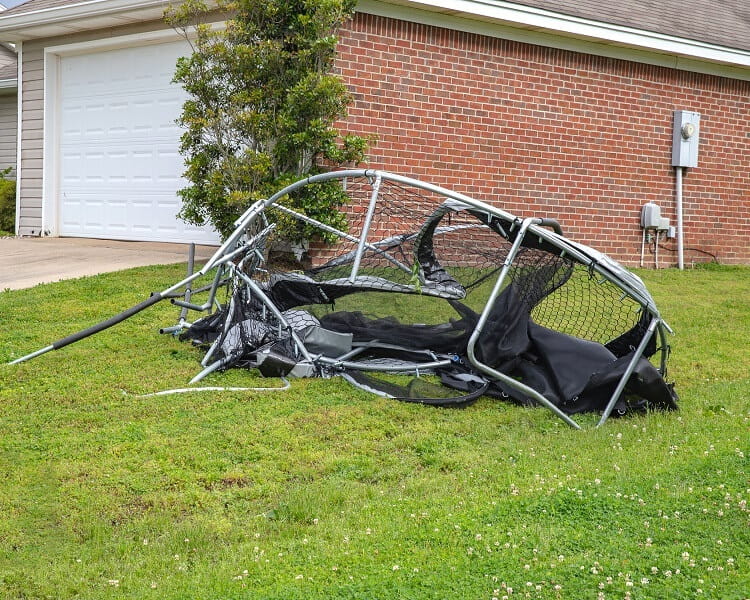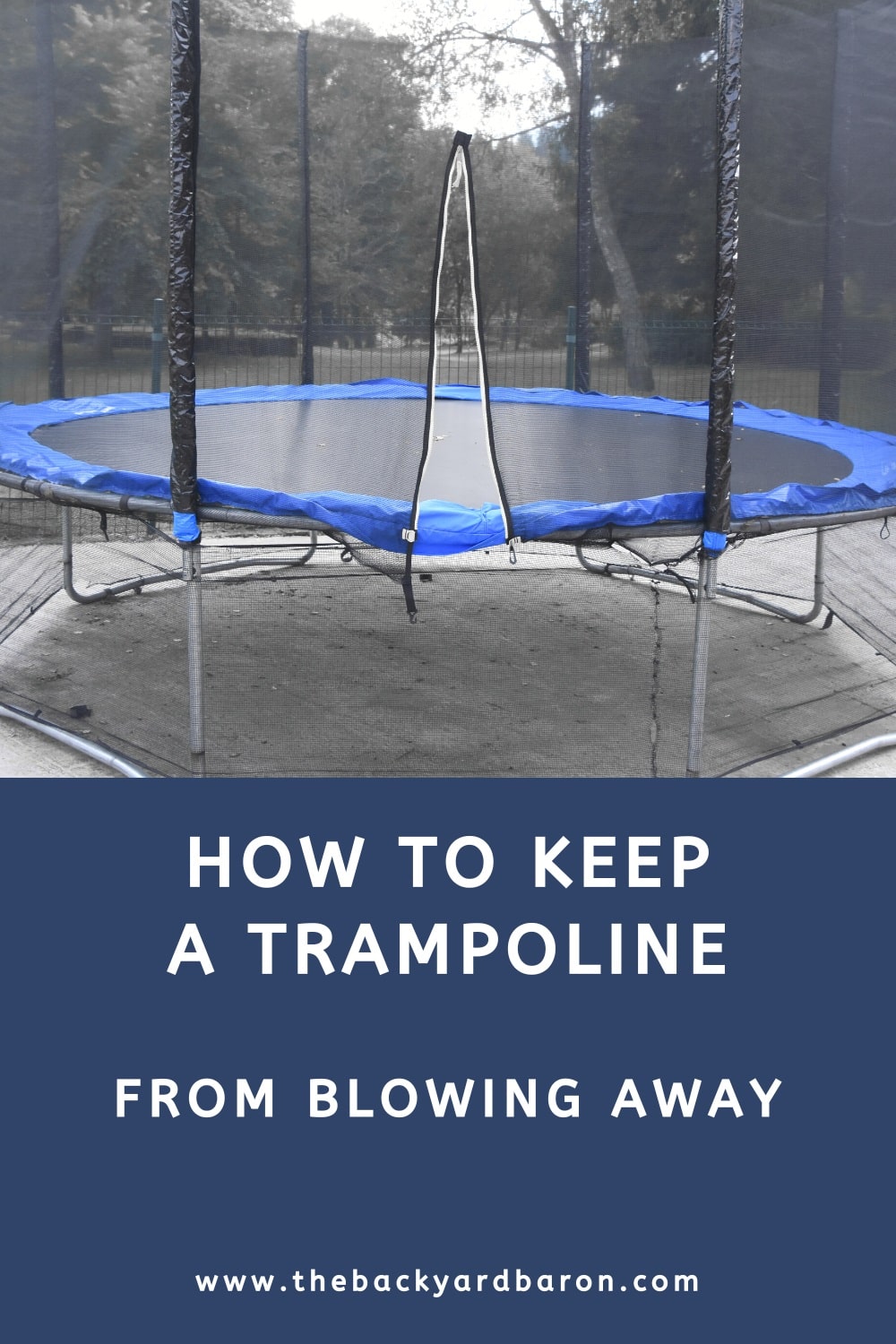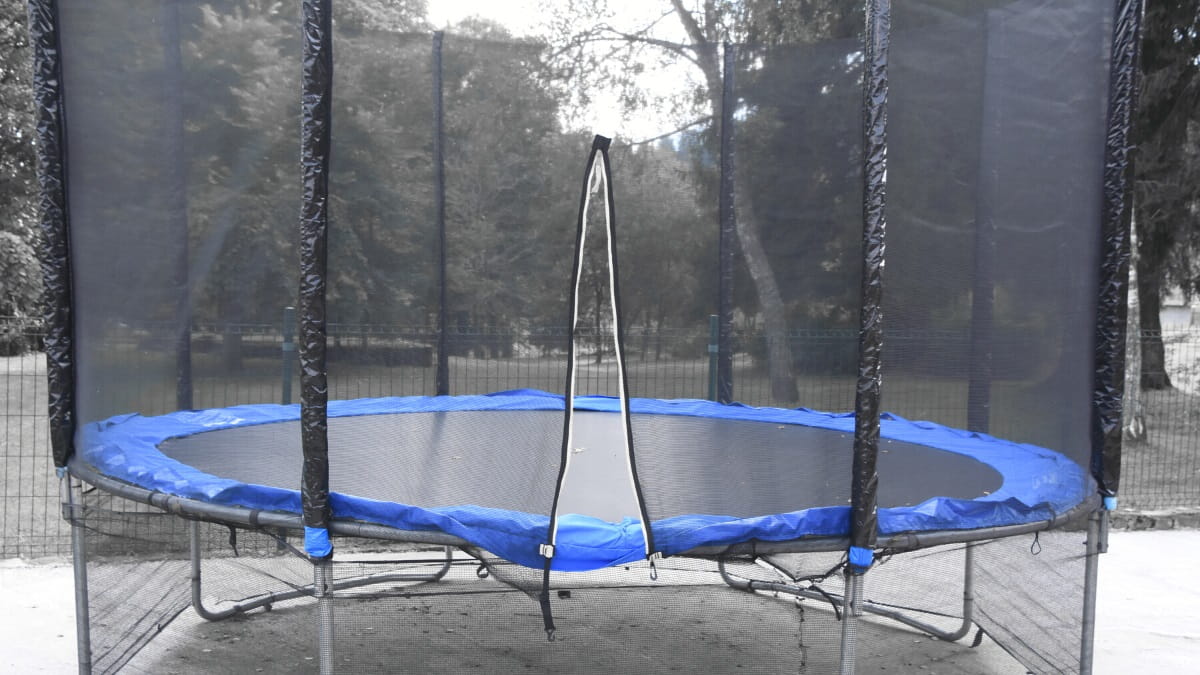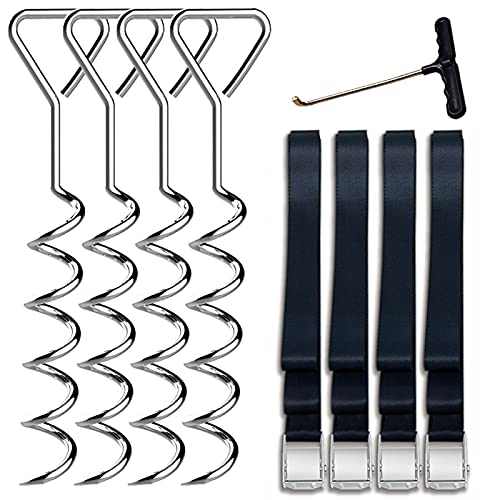I may earn a small commission from purchases made through product links on this website at no extra cost to you. As an Amazon Associate I earn from qualifying purchases.
Last updated: March 18, 2024
This practical guide explores two ways to secure a trampoline and prevent it from blowing away in rough weather conditions.
If you have a trampoline in your backyard or are about to purchase one, you may wonder how to keep it secured during strong winds and storms.
We’ve all seen videos of trampolines getting blown away during extreme weather, which is obviously something we all want to avoid.
In this guide, I will discuss two options for keeping a trampoline from blowing away and securing it in your backyard: anchoring or weighing down.
Two Ways to Secure a Trampoline
First and foremost, in case of predicted hurricanes and severe storms, try to move the trampoline indoors. Even if the trampoline is secured, a hurricane or heavy storm is too much of a risk.
In more common conditions, such as high winds, there are generally two options to keep a trampoline from blowing away without having to move it indoors:
- Anchoring the trampoline
- Weighing down the trampoline
Let’s discuss these two options in a bit more detail.

1. Anchoring the Trampoline
A reliable and relatively easy way to ensure your trampoline doesn’t budge an inch during storms and high winds is to use anchors to secure it firmly in the ground.
The anchor you choose to use and how you install it depends on the trampoline model you have, where you’re located, and your personal preference.
There are typically two ways to anchor a trampoline:
- Anchor kits (with straps)
- Wind stakes
Let’s look at these two primary ways of anchoring a trampoline and the advantages and disadvantages of each.
1.1 Anchor Kits (With Straps)
Done-for-you anchor kits usually consist of straps and corkscrew-like stakes. They provide an effective way to ensure your trampoline doesn’t blow away.
The anchors typically use high-quality galvanized steel, so they don’t rust or get corroded and can stay strong for years. They’re strong enough to hold down a larger-sized trampoline and keep it secured during strong winds.
There are two types of anchor kits, and the type you choose will mainly depend on what kind of trampoline you have.
U-Shaped Anchors:
Anchoring using steel U-shaped anchors is a basic way of securing a trampoline and is also cheaper. They are easy to install with a hammer, and you can fit them directly around the trampoline’s main poles.
That said, they’re not the most reliable form of anchoring as they only provide basic protection.
Augers:
Most anchor kits will have augers, also known as corkscrew trampoline anchors. Due to its shape, an auger is considered a more reliable way of trampoline anchoring.
Augers are garden-friendly and relatively easy to set up. They twist into the ground like a corkscrew and have an attachment at the top where you attach the straps.
An example of a suitable anchor kit is this heavy-duty trampoline anchor kit.
- Rugged and Heavy-Duty: Crafted from galvanized steel, these heavy duty...
- Easy Installation: Installing these spiral trampoline stakes is a breeze. Simply...
- Enhanced Stability: Our heavy duty trampoline wind stakes are generally...
This anchor kit comes with a set of 4 heavy-duty trampoline stakes and trampoline anchors. The galvanized ground screws help prolong the anchor’s lifespan by reducing the chance of rusting and early deterioration.
The kit has metal buckles and rigid nylon straps. The steel corkscrew anchors wind into the ground deep enough to keep the trampoline stable.
An anchor kit like this will keep your trampoline safe during windy conditions, and is suitable for trampolines of all shapes.
Advantages and disadvantages of anchor kits:
Anchor kits (with augers) are the most reliable way of anchoring a trampoline, but they’re more expensive than simple wind stakes. Installation also requires a bit more effort, but once it’s done, it’s done.
1.2 Wind Stakes
Wind stakes are generally less complex than anchor kits. They come in “J” or “U” shapes to secure your trampoline to the ground over its legs.
They can vary in length between 10 and 14 inches, which is sufficient to go deep enough to secure your trampoline safely. The only tool you require to install wind stakes is a hammer.
An example of suitable wind stakes is this HelleX trampoline stakes set.
- FITS- Trampoline Tube leg diameter up to 2.5"-Compatible with Most trampolines
- RUST Resistant- Made of High-Grade Zinc Plated finish Galvanized Steel to...
- VALUE Set- 8pcs 11.0Inch Heavy Duty U-Shape Stakes Anchors in one Hellex...
This particular wind stakes set comes with a trampoline tube leg diameter of up to 2.5 inches, making it compatible with most trampolines. It’s manufactured such that it’s rust-resistant with its high-grade zinc plate finish galvanized steel.
One set consists of 8 heavy-duty U-shaped stakes, which makes it better value than some of the others available. Two stakes are placed for each leg to help stabilize your trampoline.
You can quickly install these wind stakes with a rubber hammer.
Advantages and disadvantages of wind stakes:
Using wind stakes to anchor a trampoline is a simple, easy, cheap, and quick solution, but perhaps not as reliable as anchor kits with augers. The setup is easy, and no expensive tools or equipment is required to get the job done.
2. Weighing Down the Trampoline
If you’re all caught up and don’t have wind stakes or anchor kits, don’t despair. You can also weigh down the trampoline to help secure it to the ground.
2.1 Sandbags
A basic and straightforward way to put some weight on a trampoline is by using sandbags. You basically have to place sandbags on the trampoline’s legs to hold it down and ensure it doesn’t move during storms and high winds.
Using sandbags, you can also secure a trampoline on a concrete-like surface where anchor kits or wind stakes are not possible. The more sandbags you place on the legs, the more secure your trampoline will be.
Although it may be time-consuming to DIY a set of sandbags, it’s also a straightforward approach. You can use materials that are readily available; it doesn’t necessarily need to be sand.
An example of of sandbags is this set of Baser fillable garden weight bags.
- Sleek Danish design, from top to bottom! Even our sandbags demonstrate our tidy...
- Easy to use! Fill your weight bags with any kind of sand, carry them with their...
- Save time and money! Durable materials made in Europe mean less shopping for...
This set with two or four fillable weight bags is perfect for increased stability of your trampoline. The bags come with handles, which makes them easy to move around.
The bags are made with durable fabric with Teflon coating, making them suitable for dealing with all types of weather. They come with a PE plastic bag to hold and seal the sand and secure it with a sturdy velcro closure. The bags can carry a weight of up to 55 lbs.
2.2 Other Options
With a bit of imagination, there are other options available if you don’t have sandbags.
Anything heavy, such as old and heavy car tires, will do the trick. Rather than throwing them out, you can use them to secure a trampoline or any other backyard piece.
Final Thoughts
Hopefully, this guide to securing a trampoline has answered some of the questions you may have had beforehand.
It’s essential to make sure your trampoline doesn’t blow away. This is mainly for safety reasons, of course, but you also wouldn’t want to have to replace an expensive trampoline due to extensive wind damage.
If you’d like to read more about trampoline maintenance, check out my guide explaining how to patch a trampoline and my guide explaining how to clean a trampoline mat after the winter season.




